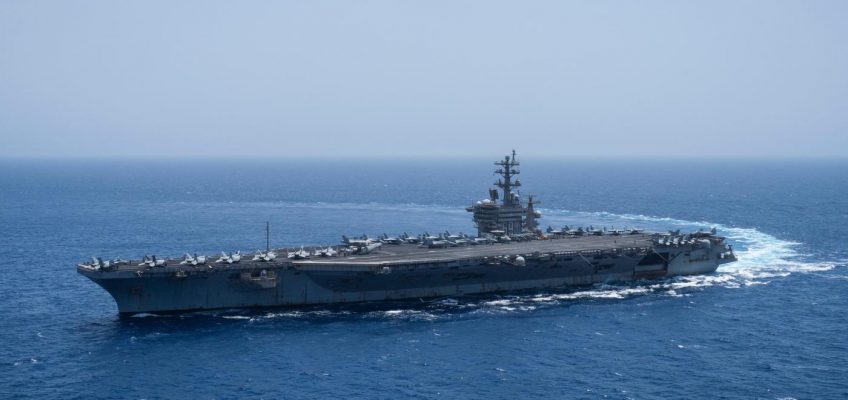By LOLITA C. BALDOR and JON GAMBRELL (Associated Press)
ABOARD THE USS DWIGHT D. EISENHOWER IN THE RED SEA (AP) — The combat markings emblazoned on the F/A-18 fighter jet tell the story: 15 missiles and six drones, painted in black just below the cockpit windshield.
As the jet sits on the deck of the USS Dwight D. Eisenhower aircraft carrier in the Red Sea, its markings illuminate the enemy targets that it’s destroyed in recent months and underscore the intensity of the fight to protect commercial shipping from persistent missile and drone attacks by the Iranian-backed Houthi rebels in Yemen.
But they also hint at the fatigue setting in, as the carrier, its strike group and about 7,000 sailors close in on their ninth month waging the most intense running sea battle since World War II. That raises difficult questions about what comes next as U.S. military and defense leaders wrangle over how they will replicate the carrier’s combat power if the ship returns home to Norfolk, Virginia.
Already, the carrier’s deployment has been extended twice, and sailors post dark memes around the ship about only getting one short break during their steadily growing tour. Some worry they could be ordered to stay out even longer as the campaign drags on to protect global trade in the vital Red Sea corridor.
At the Pentagon, leaders are wrestling with what has become a thorny but familiar debate. Do they bow to Navy pressure to bring the Eisenhower and the other three warships in its strike group home or heed U.S. Central Command’s plea to keep them there longer? And if they bring them home — what can replace them?
U.S. officials say that they’re weighing all options and that a decision is expected in the coming weeks.
U.S. commanders in the Middle East have long argued that they need an aircraft carrier in the volatile region. They say that it’s an effective deterrent to keep Iran in check and that the ship gives them critical and unique war-fighting capabilities against the Houthis, who say their attacks are aimed at bringing an end to the Israel-Hamas war in the Gaza Strip.
The massive ship is a flexible, floating flight line that can launch fighter jets on a moment’s notice, without any of the limits that host nations in the Middle East can place on Air Force aircraft taking off from bases on their soil. And those carrier-based jets can get within striking distance of Houthi weapon systems quickly without crossing borders.
“What the carrier brings is an offensive platform that’s mobile, agile and doesn’t have any access, basing or overflight restrictions,” said retired Marine Gen. Frank McKenzie, who headed U.S. Central Command for three years, ending in 2022. “It’s sovereign U.S. territory. You can do as you want with those airplanes on that carrier. So that gives you enormous flexibility when you consider response options across the region.”
Rear Adm. Marc Miguez — who commands Carrier Strike Group Two, which includes the Eisenhower and supporting ships — agrees that the aircraft carrier is crucial to America’s military.
“Every time that there’s a crisis on the globe, what’s the first thing the president asks? ‘Where are the U.S. aircraft carriers?’” Miguez told The Associated Press during a visit to the Eisenhower and the USS Laboon, one of the guided-missile destroyers accompanying it.
On any given day, Navy F/A-18s roar off the Eisenhower and take out Houthi missiles or drones preparing to launch. The U.S. warships have fired volleys of Tomahawk missiles into Yemen to destroy warehouses of weapons, communications facilities and other targets.
Pentagon leaders worry that without the Eisenhower, they will need to tap more Air Force fighter jets based in surrounding countries, including Qatar, Saudi Arabia and the United Arab Emirates.
But many Arab nations place flight or other restrictions on the types of offensive strikes the U.S. can do from their land because of regional sensitivities. Others worry about triggering another war between Saudi Arabia and Yemen or inflaming tensions with Iran.
U.S. military leaders say the U.S. can adapt and get forces where they need to be. But that can require longer fighter jet flights from distant bases, requiring refueling capabilities and presenting other hurdles.
Extending the Eisenhower’s deployment again is an option — but for many, it’s the least desirable.
Navy leaders worry about the sailors, who actually have been able to see incoming Houthi-launched missiles seconds before they are destroyed by the ship’s defensive strikes. And officials in the Pentagon are talking about how to care for the sailors when they return home, including counseling and treatment for possible post-traumatic stress.
Miguez also notes the strain on the ships themselves.
“We are constantly reminding the Department of Defense that we’re going to need to take a respite and a break, to try and get back to maintenance,” he said. “These ships are floating around in seawater. They’re steel, and they require a lot of maintenance. And when you run them past red lines, when you run them past scheduled maintenance activities, you have to pay those off somewhere down the line.”
A third option would be sending other ships — perhaps another carrier — to take the Eisenhower’s place. But the massive ships are relatively rare. The U.S. operates 11, which is about 40% of the total number worldwide. Other countries have only one or two.
The U.S. could turn to France or the United Kingdom, which each have one, for at least a temporary stint in the Red Sea. U.S. officials have insisted that protecting the sea lanes is a multinational effort and having an ally take a turn could reinforce that message. It could give the U.S. enough breathing room to get another American carrier there, perhaps late this year.
Of the 11 U.S. carriers, four are deployed, three are in training and preparing to deploy, and four are in routine maintenance and repair, which usually lasts about a year or more.
The USS John C. Stennis, however, is undergoing its major, mid-life overhaul, which can last about four years and calls for the replacement and upgrading of the ship’s nuclear propulsion system and other critical radar, communications, electronics and combat components. A carrier’s lifespan is about 50 years.
One carrier is always based in Japan and does regional patrols and exercises, and another is generally deployed to the Asia-Pacific. That focus on Asia reflects the long-stated belief that China is America’s top strategic challenge, and 60% of U.S. naval forces are based in the Pacific. The rest are Atlantic-based.
A third carrier is off South America’s west coast, heading toward Japan, leaving the Eisenhower as the only one in the Middle East or Europe.
Lacking a carrier, another option would be to deploy the USS Wasp, a large amphibious assault ship now in Europe that carries F-35 fighter jets. Those jets do short takeoffs and vertical landings, so they can do strike missions off smaller ships.
___
Baldor reported from Washington.




